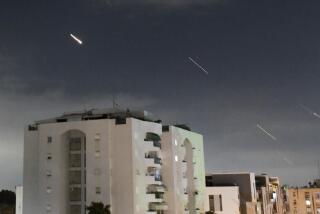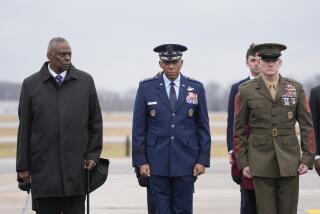Air Power--No Magic Bullet : Gulf War report shows limitation and potential
- Share via
Iraq’s defeat by the American-led coalition in the 1991 Persian Gulf War appears indeed to have been a rare historical case of assuring--if not achieving--victory through air power. Give credit for that accomplishment to the virtually unchallenged control of the skies and the relentless bombing runs carried out by 1,760 U.S. and allied combat planes. That is the chief unclassified conclusion of a lengthy, top-secret study of the air war prepared by a team of independent scholars under the sponsorship of the Pentagon.
But the study also importantly notes the limits and failures of both strategic and tactical bombing, deficiencies that were downplayed during and immediately after the war amid a blaze of claimed successes. Many of those claims have not stood up under close scrutiny. Iraq’s nuclear, chemical and biological weapons programs, for example, weren’t destroyed by precision air bombardments, as wartime briefings suggested. U.N. inspectors who went to Iraq after the war found many of its unconventional warfare facilities only minimally damaged. Some, in fact, apparently were unknown to bombing planners. Similarly, Iraq’s most effective political weapon, the mobile Scud missiles it launched against Saudi Arabia and Israel, largely escaped detection and destruction, despite claims to the contrary.
POWERFUL PUNCH: Air attacks did destroy most of Iraq’s antiaircraft capability, much of its military command and control system and a large percentage of its army’s tanks. Air attacks are also credited with drastically weakening the morale of Iraq’s troops, of no small importance in aiding swift, brilliantly executed and quickly triumphant allied ground operations.
LIMITED USE: But as the study team along with other military analysts have been quick to note, the air war against Iraq was waged under some very specific conditions. These must be kept in mind by anyone who might be tempted to assume that what happened in the skies over Iraq can be repeated elsewhere. For example:
A “very large fraction” of U.S. air power was assigned to the war. Had there been a military threat elsewhere at the same time, fewer planes could have been sent and fewer missions could have been flown, reducing the effectiveness of the air war.
Open desert provides a much more hospitable environment for successful tactical air strikes than, say, the mountains and forests of Bosnia. By the same token, it’s a lot easier to direct smart bombs against big, fixed targets--an airfield, Iraq’s ministry of defense, Saddam Hussein’s palace--than it is to locate and destroy mobile artillery pieces or missile launchers, as could be required in Bosnia.
Generals, the cliche goes, often make the mistake of trying to refight the last war. The underscored lesson of the Gulf War is that air power and the target-identification procedures it relies on proved to be highly effective in some cases and seriously deficient in others. Give credit in the gulf air war where it’s due, but be cautious in applying its lessons too widely.
More to Read
Sign up for Essential California
The most important California stories and recommendations in your inbox every morning.
You may occasionally receive promotional content from the Los Angeles Times.













